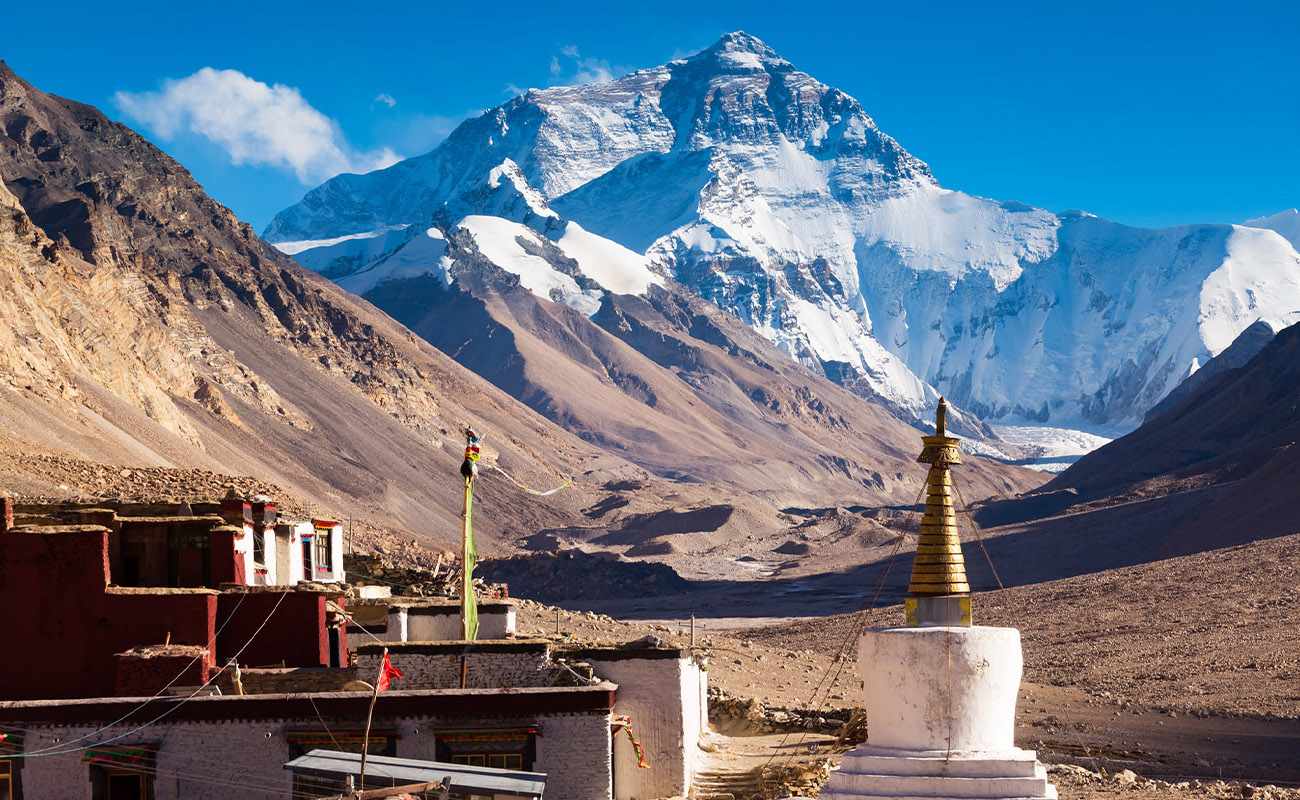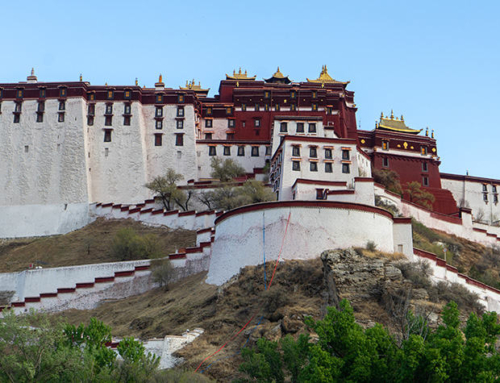Nestled in the mighty peaks of the Himalayas, Tibet, often referred to as the “Roof of the World,” unfolds a tapestry of natural wonders that captivate the soul. The awe-inspiring landscapes of this high-altitude region are not merely geographical features; they are living stories etched in the rugged terrains and sacred lakes. The journey through Tibet is a symphony of contrasts, from the formidable North Face of Mount Everest, standing tall as a testament to human determination, to the serene Yamdrok Lake, where tranquility mirrors the calmness of Tibetan spirituality. In this realm of elevated wonders, every mountain, canyon, and lake has a profound tale to tell—a narrative interwoven with the rich cultural heritage and spiritual essence that defines Tibet.
Amidst the colossal peaks and deep canyons, Tibet’s natural wonders stand as guardians of ancient secrets and testaments to the resilience of both nature and the human spirit. As one traverses this sacred land, they embark on a pilgrimage of the senses, where the beauty of the landscape merges seamlessly with the challenges it presents. Each step is a dance with the unknown, a communion with the divine energies believed to inhabit these sacred mountains, and a chance to witness the harmonious coexistence of the natural and spiritual realms. The journey through Tibet is an invitation to unravel the mysteries of the “Roof of the World,” where every vista is not just a sight to behold but an experience that transcends the ordinary, leaving an indelible mark on the wanderer’s soul.

North Face of Mount Everest
The northern side of the Himalayas holds the less-explored, challenging route to Mount Everest. While the south side is more frequented by mountaineers due to its perceived safety, the North Face beckons the adventurous spirits seeking a distinctive ascent. Here, the winds are fierce, and the surroundings exude a solitude that connects climbers intimately with the raw essence of the world's highest peak. At an elevation of 7,000 meters, the Rongbuk Glacier stands as a majestic testament to the formidable nature of Everest's northern approach. Alongside this icy giant, perched at an altitude that touches the heavens, lies one of the world's highest monasteries, a place where spirituality and the grandeur of nature coalesce.
The transformative power of accessibility is epitomized by the Friendship Highway, a remarkable feat of engineering that has altered the narrative of reaching Everest's base camp. What was once a grueling and arduous trek for the most seasoned climbers has now become an accessible journey for the average adventurer. The three-hour scenic drive from Lhasa unfolds like a visual poem, where the quietest highway in the world offers not only tranquility but also panoramic views of 8,000-meter mountains. The Friendship Highway not only connects distant points but also bridges the gap between the formidable grandeur of Everest's North Face and the adventurous souls yearning to witness it firsthand.
Yarlung Tsangpo Grand Canyon
Carving its way through the heart of the Tibet Autonomous Region, the Yarlung Tsangpo Grand Canyon stands as the world's deepest canyon, an awe-inspiring testament to the immense forces that have shaped this rugged landscape. With depths averaging nearly 5,000 meters and reaching over 6,000 meters at its lowest point, the canyon unfurls a geological saga that spans millennia. The Yarlung Tsangpo River, born from the sacred Mount Kailash, flows with majestic determination through the canyon, its powerful currents carving through the rock with a relentless force that echoes the ancient tales of this mystical land.
In the midst of this geological wonder, against all odds, settlements like Zhibe thrive within the canyon, providing a testament to the indomitable spirit of the Tibetan people. The resilience displayed by these communities in one of the harshest environments on Earth is both humbling and inspiring. Their existence within the depths of the Yarlung Tsangpo Grand Canyon adds a human dimension to the staggering natural beauty, underlining the harmonious coexistence of humanity and nature in a place that challenges the very limits of survival. In exploring this canyon, one doesn't merely witness the grandeur of nature; they also encounter the unwavering spirit of those who have made this formidable gorge their home.
Yamdrok Lake
Situated at an elevation of almost 4,500 meters, Yamdrok Lake emerges as one of the highest freshwater lakes globally, cradled amidst the lofty peaks of the Tibetan landscape. Its vast expanse reflects the ethereal beauty of untouched nature, surrounded by a majestic amphitheater of snow-capped mountains that mirror themselves in the crystal-clear waters. This high-altitude sanctuary radiates a tranquility that transcends the ordinary, inviting visitors to immerse themselves in a serene retreat far from the hustle and bustle of the world below. Yet, despite its calmness, the growing influx of tourists occasionally disturbs the peaceful harmony that defines this alpine haven.
As more visitors seek the solace offered by Yamdrok Lake, the calmness of its waters becomes intermittently disrupted by the vibrancy of human activity. The allure of the lake, however, extends beyond its natural beauty. Amidst the serenity, encounters with Tibetan mastiff hawkers add a unique layer to the experience. These vendors, with their majestic canine companions, offer a distinctive blend of nature and commerce, where the ancient traditions of Tibetan culture intertwine with the modern dynamics of tourism. The juxtaposition of tranquility and occasional vibrancy paints a dynamic portrait of Yamdrok Lake, where every visit promises not just a visual feast but a cultural immersion into the heart of Tibet's natural wonders.
Mount Kailash
Elevating to over 6,500 meters, Mount Kailash stands as a sacred sentinel, revered by various religions, including Hinduism, Buddhism, and Jainism. Its lofty peaks preside over the sacred lakes Manasarovar and Rakshastal, creating a divine triad in the heart of Tibet. Pilgrims and curious tourists alike undertake journeys to this spiritual haven, not seeking the typical conquest of a summit but rather to immerse themselves in the profound energy that emanates from the mountain. Mount Kailash beckons as a place of introspection, where the journey itself becomes a pilgrimage, and every step is a communion with the sacred forces that are believed to reside within.
Despite the allure of its heights, Mount Kailash remains untouched by human hands. The sacred nature of the mountain prohibits treks or physical contact, preserving its pristine sanctity. This unique characteristic accentuates the divine significance attributed to Mount Kailash, emphasizing that its spiritual energy is to be respected and revered from a distance. The mountain's unspoiled grandeur, coupled with the spiritual fervor that surrounds it, transforms every visit into a profound encounter with the mystical heart of Tibet, making Mount Kailash an unparalleled destination for those seeking a transcendent connection with nature and spirituality.
Lhasa: The Capital
Perched at an altitude of approximately 3,700 meters, Lhasa, the capital of Tibet, is not just a city; it's a living testament to the cultural richness and spiritual depth that defines the region. The city's charm is heightened by the meandering Lhasa River, which gracefully winds its way through the heart of this ancient capital. The juxtaposition of ancient monasteries, traditional Tibetan architecture, and the modern pulse of daily life creates an ambiance that resonates with the soul of Tibet. Lhasa stands as a living museum, where the legacy of centuries unfolds against a backdrop of towering mountains and a sky that seems to touch the heavens.
While Lhasa is accessible by air from mainland China, the more enchanting journey is an iconic train ride that traverses the awe-inspiring landscapes of the Tibetan plateau. This journey not only provides access to the capital but also serves as a gradual acclimatization to the high altitude, a crucial aspect for those arriving from lower elevations. As the train snakes its way through the breathtaking vistas, passengers are treated to mesmerizing sights of snow-capped peaks, expansive plateaus, and ancient monasteries perched precariously on hillsides. The train ride to Lhasa is not just a means of transportation; it's a poetic prelude to the wonders that await in the mystical heart of Tibet.
Friendship Highway Journey
Embarking on the Friendship Highway is not just a journey; it's a passage through the heart of Tibetan grandeur, a marvel of Chinese engineering that seamlessly connects Lhasa to the iconic Everest Base Camp. This perfectly paved road, winding through the undulating landscapes, is a testament to human ingenuity against the backdrop of the mighty Himalayas. The Friendship Highway transforms the once challenging and rugged trek to Everest into a serene and efficient drive, reducing the travel time to just under three hours.
As the wheels gracefully roll along the smooth surface of the Friendship Highway, passengers are treated to an unrivaled spectacle of nature's magnificence. The journey unveils panoramic views of 8,000-meter mountains, standing tall and majestic, seemingly embracing the highway in a silent salute to the adventurers on their quest to reach the Everest Base Camp. The quietude that envelops this highway adds a layer of tranquility to the voyage, creating an atmosphere where the only sounds are the gentle hum of the engine and the whispers of the wind against the colossal peaks. The Friendship Highway is more than a conduit; it's a pilgrimage route, inviting travelers to partake in the awe-inspiring beauty of Tibet in a way that is both accessible and profoundly moving.
The Serenity of Yamdrok Lake
Nestled at an elevation of close to 4,500 meters, Yamdrok Lake stands as a serene jewel cradled in the embrace of snow-capped peaks, offering a sanctuary for those seeking solace amidst the rugged grandeur of Tibet. The stillness of its azure waters reflects the majesty of the surrounding landscape, creating a tranquil haven where time seems to stand still. Encircled by mountains that touch the sky, Yamdrok Lake becomes a silent witness to the ever-changing hues of nature, from the ethereal glow of sunrise to the soft hues of twilight. It is a place where the quietude is profound, inviting contemplation and connection with the profound spirituality that defines Tibet.
Yet, the serenity of Yamdrok Lake faces a subtle challenge as the allure of its pristine beauty draws an increasing number of tourists. The once untouched calm occasionally yields to the vibrancy of human activity. Tibetan mastiff hawkers, with their magnificent canine companions, add a unique layer to the experience, introducing an unexpected blend of tradition and commerce against the backdrop of this natural wonder. The dynamic interplay between the lake's serenity and the influx of visitors highlights the delicate balance between preserving the sanctity of nature and accommodating the curiosity of those drawn to its beauty. Yamdrok Lake, despite the occasional ripples of change, remains a testament to the enduring allure of Tibet's natural wonders.
Mount Kailash's Spiritual Aura
Mount Kailash, enshrined in ancient Hindu scripture as a sacred abode of divine energies, stands as a beacon that beckons seekers of spirituality from diverse faiths. Its majestic peaks, soaring over 6,500 meters, create an awe-inspiring backdrop for pilgrims and curious travelers alike. The mountain's spiritual aura is palpable, an intangible force that transcends the physical realm, leaving an indelible mark on those who venture into its presence. Pilgrims, guided by a profound sense of devotion, embark on the circuitous Kailash kora, not as a trekking expedition but as a sacred journey to circumambulate the mountain and absorb the divine energies believed to reside within.
Adding to Mount Kailash's spiritual allure is its geographical proximity to the sacred lakes Manasarovar and Rakshastal. The convergence of these pristine bodies of water with the sacred mountain forms a trinity of spiritual significance, creating a pilgrimage route of unparalleled sanctity. For those who make the journey to Mount Kailash, it is not merely about conquering heights but about attaining spiritual heights. The mountain's spiritual aura, heightened by the surrounding sacred lakes, transforms every visit into a communion with the divine, making Mount Kailash an essential destination for those yearning for a profound connection with nature, faith, and the higher realms.
Yarlung Tsangpo Grand Canyon's Hidden Life
Beneath the towering cliffs and within the depths of the Yarlung Tsangpo Grand Canyon lies a hidden life that defies the harshness of its surroundings. While the canyon boasts extreme depths, plummeting nearly 5,000 meters and reaching over 6,000 meters at its lowest point, it is not devoid of human presence. Zhibe, the largest settlement within the canyon, stands as a testament to the remarkable adaptability of the human spirit. Amidst the rugged terrain and formidable cliffs, a community thrives, creating a human dimension within this geological marvel. The juxtaposition of extreme landscapes and human settlements introduces a unique perspective, showcasing the resilience and resourcefulness of those who have made the Yarlung Tsangpo Grand Canyon their home.
Zhibe's existence within the canyon adds layers of complexity to the narrative of this geological wonder. The settlement, in the midst of nature's extremes, becomes a microcosm of life's tenacity, where communities carve out a living against all odds. The canyon, once perceived solely for its geological magnificence, transforms into a living canvas, illustrating the coexistence of humanity and nature in an environment that challenges the very limits of survival. In exploring the Yarlung Tsangpo Grand Canyon, one not only delves into the depths of Earth's splendor but also discovers t
Everest's Northern Challenge
The North Face of Mount Everest stands as a formidable challenge, luring adventurers with its unique, less-explored route. In contrast to the more frequented southern side, the northern route poses distinct challenges, marked by harsh weather conditions and a sense of isolation. Historical tragedies and daunting obstacles were once synonymous with attempts on Everest's North Face, with avalanches claiming lives and adding a somber note to the mountain's reputation. However, in recent times, the narrative has undergone a transformation. The construction of the Friendship Highway, a marvel of engineering, has not only opened up access but has also reshaped the once perilous journey into a more attainable adventure for the average tourist.
The Friendship Highway, snaking its way through the Tibetan plateau, has redefined the approach to Everest's North Face. What was once a treacherous and daunting trek reserved for the most experienced climbers is now a scenic three-hour drive from Lhasa. This transformation has not only made the journey more accessible but has also democratized the experience, allowing those with a spirit of adventure to witness the grandeur of the world's highest peak. The Friendship Highway not only connects distant points but also bridges the gap between the historical challenges of Everest's North Face and the aspirations of intrepid travelers, making the once-exclusive expedition a possibility for a broader audience.
Accessibility to Everest Base Camp
The transformative power of the Friendship Highway extends beyond linking Lhasa to Everest; it has redrawn the map of accessibility to Everest Base Camp. What was once a challenging trek that demanded physical endurance and mountaineering skills has evolved into a remarkably accessible adventure—a mere three-hour drive along the quietest highway in the world. This feat of engineering not only shortens the travel time but also opens the gateway to an unparalleled expedition for adventurers of various backgrounds and experience levels.
As travelers traverse the Friendship Highway towards Everest Base Camp, they are not just covering distance; they are embarking on a gratifying journey that unveils the breathtaking grandeur of the Tibetan plateau. The panoramic views of 8,000-meter mountains that greet them at the end of this quiet highway are not only a testament to human engineering prowess but also a reward for those who dare to dream of standing in the shadow of Everest. The Friendship Highway, with its scenic charm and ease of access, has turned what was once an exclusive pilgrimage for seasoned climbers into an achievable aspiration for all who seek to witness the majesty of the world's highest peak.
Namtso: Tibet's Largest Lake
Lake Namtso, sprawling across an expansive 1,920 square kilometers, stands as the largest lake in Tibet, a shimmering gem amidst the Himalayan plateau. Beyond its sheer size, Namtso holds within its embrace a treasure trove of natural and spiritual wonders. The lake offers not only breathtaking panoramas of its azure waters against the backdrop of snow-capped peaks but also a sanctuary for reflection and contemplation. Nestled along its shores are cave-temples and shrines, silent witnesses to the spiritual history that reverberates through Tibet. A contemplative nunnery, poised in quiet solitude, adds another layer to Namtso's significance, making it not just a geographical marvel but a cultural and spiritual epicenter within the realm of Tibet's sacred lakes.
Amidst the sacred lakes that dot the Tibetan landscape, Namtso distinguishes itself as one of the most stunning, a testament to the captivating allure of nature's grandeur. Every vista around Lake Namtso is a canvas painted with the hues of spirituality and natural beauty, inviting those who visit to immerse themselves in a sensory journey that transcends the ordinary. The vastness of Namtso's surface mirrors the expansive richness of Tibetan culture and traditions, making it a destination that not only captivates the eyes but also stirs the soul, leaving an indelible mark on all who are fortunate enough to witness its splendor.
Namtso: Tibet's Largest Lake
Lake Namtso, sprawling across an expansive 1,920 square kilometers, stands as the largest lake in Tibet, a shimmering gem amidst the Himalayan plateau. Beyond its sheer size, Namtso holds within its embrace a treasure trove of natural and spiritual wonders. The lake offers not only breathtaking panoramas of its azure waters against the backdrop of snow-capped peaks but also a sanctuary for reflection and contemplation. Nestled along its shores are cave-temples and shrines, silent witnesses to the spiritual history that reverberates through Tibet. A contemplative nunnery, poised in quiet solitude, adds another layer to Namtso's significance, making it not just a geographical marvel but a cultural and spiritual epicenter within the realm of Tibet's sacred lakes.
Amidst the sacred lakes that dot the Tibetan landscape, Namtso distinguishes itself as one of the most stunning, a testament to the captivating allure of nature's grandeur. Every vista around Lake Namtso is a canvas painted with the hues of spirituality and natural beauty, inviting those who visit to immerse themselves in a sensory journey that transcends the ordinary. The vastness of Namtso's surface mirrors the expansive richness of Tibetan culture and traditions, making it a destination that not only captivates the eyes but also stirs the soul, leaving an indelible mark on all who are fortunate enough to witness its splendor.
Conclusion
In the lofty realms of Tibet, where the air is thin and the peaks touch the heavens, nature unfolds its most magnificent tapestry. From the formidable North Face of Everest to the breathtaking depths of the Yarlung Tsangpo Grand Canyon, the tranquil shores of Yamdrok Lake, and the sacred serenity of Mount Kailash, each natural wonder tells a story of resilience, spirituality, and untamed beauty. As you traverse this sacred land, you embark on a journey that transcends the ordinary, inviting you to witness the grandeur of nature in its purest form.
Tibet's natural wonders are not mere geographical features; they are portals to a realm where the sacred and the sublime intertwine. The landscapes and landmarks beckon explorers to delve into a world where every mountain, canyon, and lake carries the echoes of ancient tales and spiritual significance. In the quietude of Yamdrok Lake and the imposing presence of Mount Everest, in the hidden settlements of the Yarlung Tsangpo Grand Canyon, and the spiritual aura of Mount Kailash, one finds not only a visual spectacle but an invitation to connect with the profound energies that define the Roof of the World. In concluding this journey through Tibet's natural wonders, one is left with more than memories—they carry with them the essence of a sacred pilgrimage, a communion with the extraordinary forces that shape both the land and the spirit of this awe-inspiring region.
Explore Tibet with a local Tibetan Travel Agency
If you're looking to explore Tibet, starting your journey with a reputable Tibetan travel agency in Tibet is crucial. Tibet Travel & Tours is a great choice to begin your adventure with their extensive knowledge of the region and commitment to responsible tourism.
Their Tibet tour packages cater to a range of interests and budgets, making it easy to plan a trip that suits your needs. Before embarking on your tibet tour, it's essential to have the right Tibet travel information and necessary documents, including a Tibet travel permit.
The Tibet Travel Planner provided by i-Tibet travel is an excellent resource to plan your trip, including tips on what to pack, where to stay, and what to see.
For beginners, the "About Tibet" guide provided by i-Tibet travel offers a comprehensive overview of the region's history, culture, and top attractions. So, start your Tibet travel plan here with i-Tibet travel and discover the magic of Tibet for yourself.
About Tibet Travel & Tours
Tibet Travel & Tours is a local travel agency in Tibet that offers unique and authentic experiences to travelers from all around the world. As a leading tour operator in Tibet, we provide high-quality Tibet Travel services that are tailored to our clients' needs and preferences.
Our team of experienced and knowledgeable professionals strives to ensure that our clients have a hassle-free and memorable trip in Tibet. We specialize in various types of tours, including cultural tours, trekking and hiking tours, and adventure tours.
Our commitment to providing exceptional service has earned us a reputation as one of the best local travel agencies in Tibet. Contact us today to plan your unforgettable trip to Tibet.









